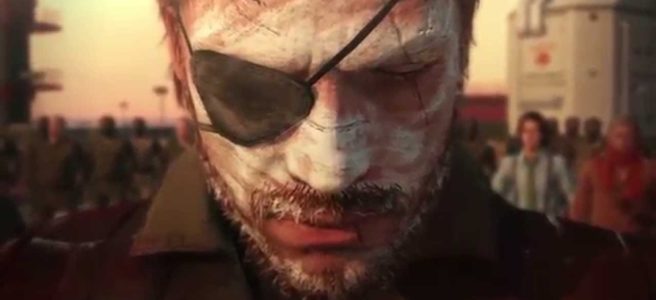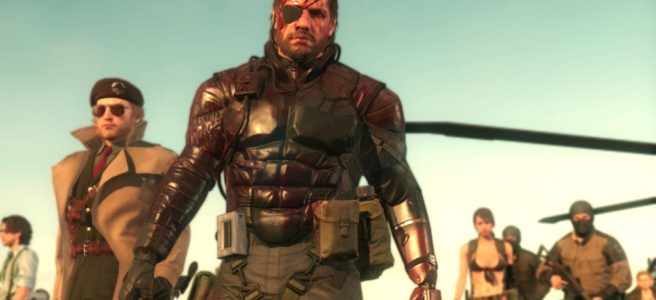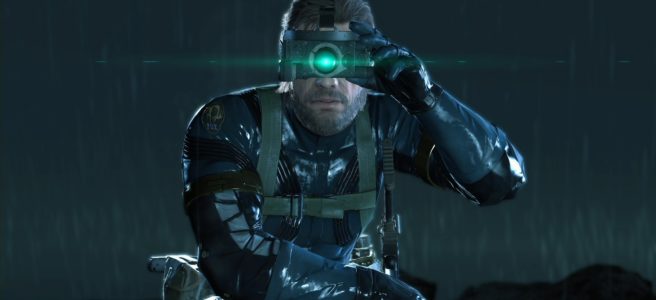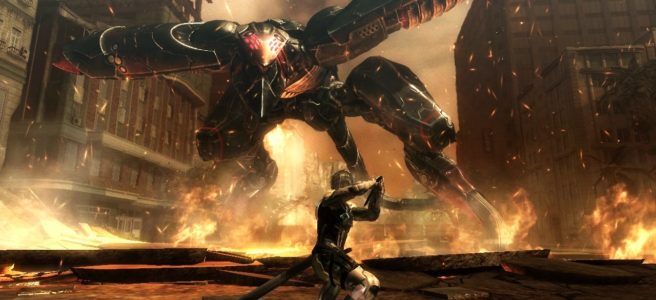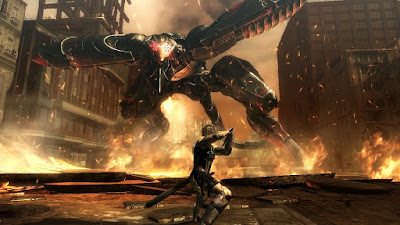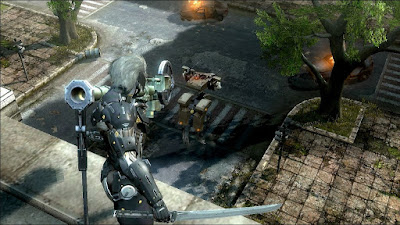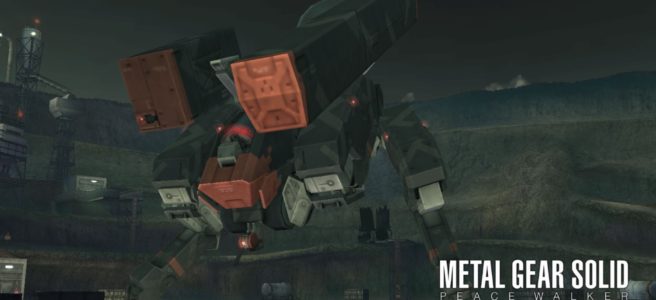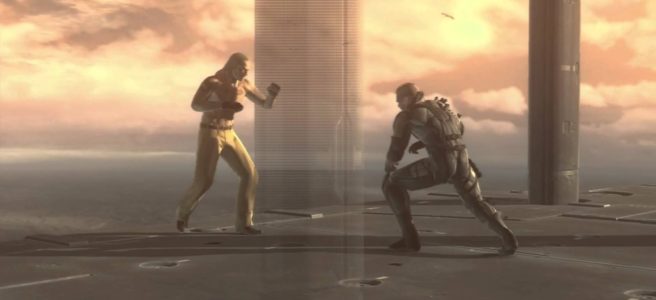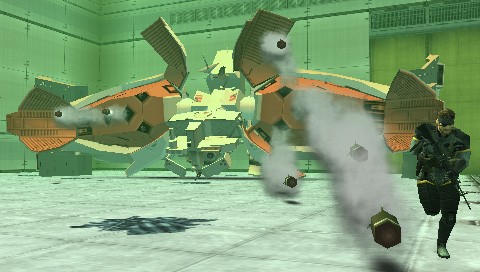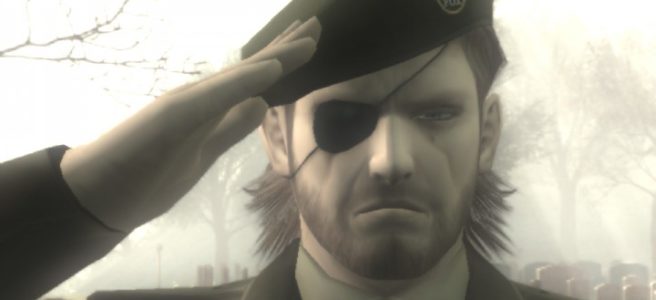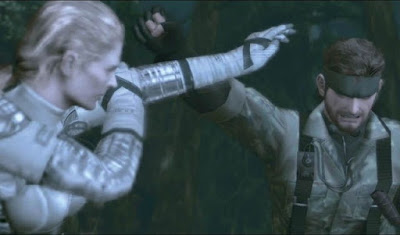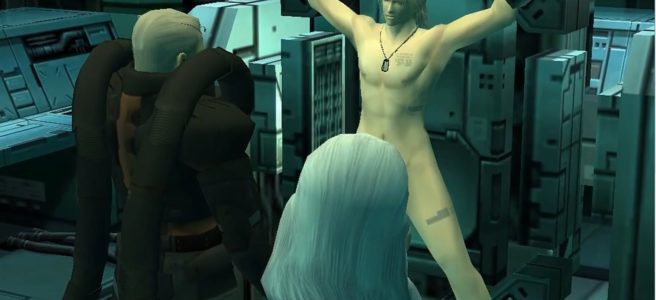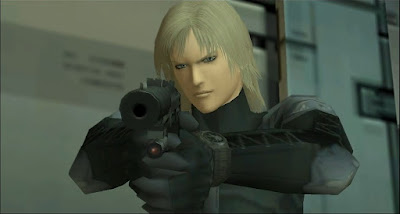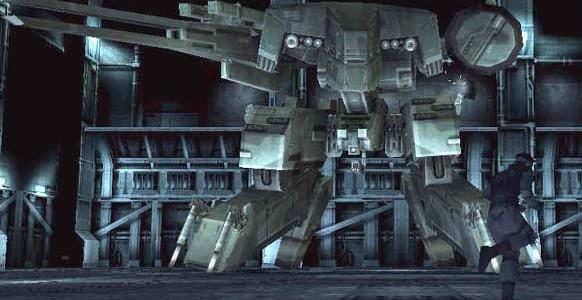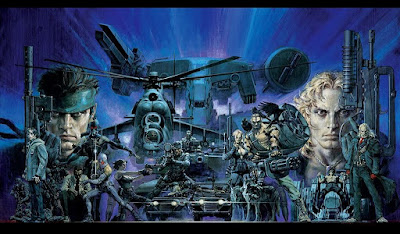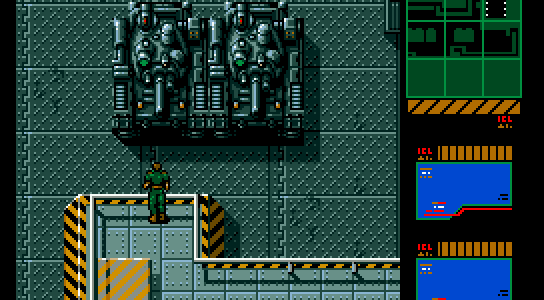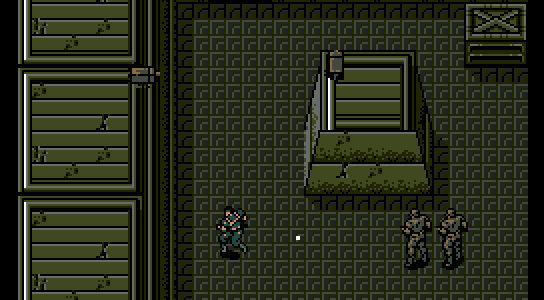Welcome back to the Metal Gear retrospective! In this entry we’re going to cover the seventh entry in the franchise, 2008’s Metal Gear Solid 4: Guns of the Patriots. After years upon years of convoluted storytelling and epic moments, it looked as if the Metal Gear franchise was finally drawing to a close, with a storyline that promised to wrap up Solid Snake’s story for good. After all the batshit insanity that had characterized the franchise up until this point though, was it even possible to produce a game that could tie together the disparate elements of Metal Gear lore? Read on to find out…

DEVELOPMENT
After the completion of Snake Eater, Kojima announced that he would be retiring from the Metal Gear series (he had previously made this declaration after Metal Gear Solid and Sons of Liberty, but he seemed to actually intend to go through with it this time). Shuyo Murata, co-writer of Snake Eater and the director of the Kojima-related Zone of the Enders: The 2nd Runner, was announced to be the game’s director. However, Kojima soon took over directing, writing and producing the game with Murata after some extreme fans became absolutely livid, sending out death threats to get Kojima back in charge.
Guns of the Patriots was officially announced in 2005 at a Sony press conference and then at E3, where it was revealed to be a culmination of the Solid Snake storyline, tying up all the story arcs for the characters and bringing back most of the surviving fan favourites. It was also announced that the game would be a PS3 exclusive as the franchise had been fostered on PlayStation hardware for the last 3 entries, although he was open to potentially porting it. Over time, it was also revealed that Snake would be significantly aged for this appearance and that this would be the last game in the Metal Gear series. An emphasis was placed on stealth within an “evolving battlefield”, with the option being there to befriend a faction to sway the tide of the battle. This was summed up by the philosophy of “No Place to Hide”, forcing the player to utilize faction allegiances and the new OctoCamo system.
The game also had a few scenes of female nudity which were cut – specifically, the Beauties were supposed to be naked, and the female undergarments that Snake finds at the end of Act II were actually supposed to lead to a naked female soldier. These were cut to avoid a potential AO rating though (I can understand the Beauties as that would have been ridiculously gratuitous considering how much the camera lingers on their clothed boobs and butts already, but I don’t see how the naked female soldier would have been something that would land the game an AO rating).
Shortly before the game’s release, Kojima revealed that the PS3 hardware hadn’t left him entirely satisfied. His development team had entirely filled up the 50GB Blu-Ray disc limit for the game and had still been forced to compress elements to get it all to fit, reducing the quality of (for example) textures. The PS3’s Blu-Ray drive and limited HDD space also necessitated chapter-by-chapter installs to reduce load times.
The game was released on June 12, 2008, early in the PS3’s lifecycle. As a result, it predated the release of the PlayStation Network trophy system, meaning that the game had no trophies to acquire. Fans requested this feature to be patched in for years, but it seemed that this would never happen. However, in the summer of 2012, it was finally revealed that Konami was going to patch trophies into the game. The news was welcome, but people who have played the game can tell you that the amount of work required to get a Platinum in this game is insane – you have to beat the game at least 7 times and put in at least 100 hours of work to receive it. Considering that the game had already been out for 4 years and that some players had actually done the requirements to get the Platinum already before the patch (with no compensatory reward), it’s simply not worth the effort to acquire it in my opinion. The trophy patch coincided with an option to fully-install the game instead of having to install at the start of every new chapter, filling in one of the game’s biggest complaints on launch.
Guns of the Patriots also played host to the next generation of Metal Gear Online. It was the first online shooter that I really got into and I used to play this all the time. It was slower-paced and far more unique than most online shooters of the era (this was when Call of Duty was really starting to take off). I have many a fond memory of laying down Playboy traps to catch enemies off guard and then take them out, as well as being the deadliest sniper in most matches that I played in. The game played well, but it predated the uniform adoption of PSN synchronicity across online games, meaning that you had to log into 2 separate Konami accounts to actually play online. It could also be very difficult, as headshots were lethal with basically any weapon. Unfortunately, MGO‘s servers were shut down around the time that the trophy patch was released. Still, it was a very fun experience that I will always remember very fondly. Playing through Guns of the Patriots‘ areas which were reused for maps in MGO brought the memories flooding back…
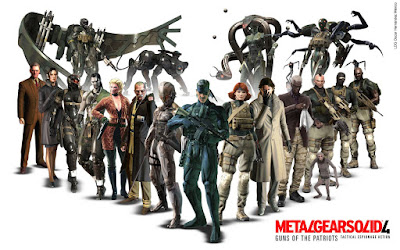
PLOT SUMMARY
5 years after the Big Shell incident, Solid Snake has been stricken with a form of accelerated aging which has made him prematurely grow into the equivalent body of a 70-year-old man – by all estimates, he only has about a year left to live, at best. Roy Campbell, now working for the UN, tracks Snake and Otacon down and tells them that they have located Liquid Ocelot. Campbell explains the global situation that has developed in the last 5 years. Ever since the Big Shell incident, the US has taken a backseat in international affairs and PMCs have risen in prominence utilizing a synchronized, nanomachine-assisted network system called SOP, Sons of the Patriots. This results in less war crimes due to emotion control, more efficiency due to real-time updates and synchronicity and ID locks on all weapons, meaning that no authorized weapon can be fired without government permission. As a result, states have outsourced war to the PMCs, resulting in a global “War Economy” as PMCs battle one another in proxy wars. Campbell reveals that most of the largest PMCs are actually controlled by a single overarching organization calling itself “Outer Heaven”, controlled by Liquid Ocelot. Liquid is planning some sort of insurrection against The Patriots and plunge the world into chaos. With the international reliance on the War Economy, no one is willing to disrupt him for fear of destabilizing their own finances. Campbell requests that Snake assassinate Ocelot, who has been spotted in a warzone in the Middle East, which Snake accepts hesitantly. Campbell tells Snake that he will be able to meet up with a UN inspection team for Liquid’s exact location.
Snake is then sent to this warzone, disguised as a member of the local militia unit. They soon come under fire from Praying Mantis PMC forces and their Metal Gear-esque unmanned mechs, Gekkos (aka, IRVING), which wipe out the militia forces. Snake sneaks past the Gekkos and links up with Metal Gear Mk. II, a small, remote-control drone operated by Otacon. The Mk. II provides Snake with weapons and equipment (including the new Solid Eye HUD device) before they move on. Making his way through the warzone, Snake encounters a mysterious man calling himself Drebin 893, who claims to be able to launder ID locked weapons. Since he is not a licensed soldier, Snake lacks the proper nanomachines to operate weapons without ID locks so he cautiously accepts Drebin’s services. Drebin gives Snake an M4 Custom free of charge, but the weapon is still ID locked, forcing Drebin to inject Snake with more up-to-date nanomachines in order for the ID lock bypass to work. This proves to be successful, and Snake moves on to meet up with the UN inspection team.
After fighting his way further through the warzone, Snake encounters Rat Patrol Team 01, the UN inspection unit, consisting of Ed, Jonathan, Johnny “Akiba” Sasaki, and led by Meryl Silverburgh. The pair reminisce a bit before Snake and Meryl get down to business. She tells him that Liquid has a camp ahead, but grows angry when she discovers that Snake is working with Campbell – she believes that her true father is a womanizing piece of shit after finding out that he cheated with her mother and that he is now married to a woman the same age as her. However, they are soon interrupted when Akiba accidentally alerts the PMC forces to their position with the reflection off his binoculars. Snake and Rat Patrol come under attack by Liquid’s FROGS unit, forcing them to fight their way out of the building they had holed up in. When the last FROGS are cleared out, Snake and Rat Patrol split up to go their separate ways.
Heading to Liquid’s camp, Snake watches as a militia unit is violently wiped out by 4 technologically augmented soldiers from the Beauty and the Beast Unit. After they disperse, Snake makes his way into the PMC camp and spots Liquid. He moves closer but spies Meryl and Rat Patrol inside the camp as well. Meryl gets angry at Snake because she thought that they were supposed to be only performing a threat assessment. Before anyone can do anything though, Liquid conducts some sort of live test which causes everyone, from PMC forces, to Rat Patrol (except for Akiba, conspicuously), to Snake himself, to begin convulsing and freak out. As he begins passing out, Snake spots Naomi Hunter with Liquid, before Akiba drags Snake to safety.
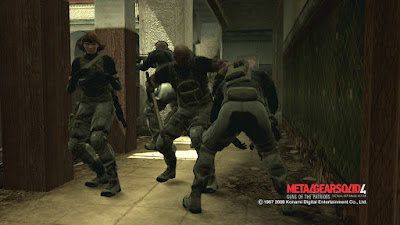
Snake later comes to in the Nomad, Philanthropy’s mobile, airborne base of operations. Otacon reveals that he and Sunny Gurlukovich (Olga’s daughter who Raiden rescued from The Patriots after the Big Shell incident) have decoded a transmission from Naomi Hunter. In the transmission, she reveals that the next phase of his tests will be in South America. Liquid has been forcing her to help him due to her expertise in nanotechnology. She begs Snake to rescue her. Realizing that they have no other leads on Liquid’s whereabouts, Snake and Campbell agree that they need to rescue Naomi in order to make any more progress. They speculate that Liquid must be attempting to destroy SOP, as it is clearly a part of The Patriots’ information control agenda. Snake isn’t sure whether Liquid or The Patriots are worse, but Campbell cautions that without SOP, there will be even more war and atrocities committed, meaning that The Patriots are the lesser of two evils in order to keep modern society afloat.
When he reaches the PMC security perimeter, Snake witnesses Laughing Octopus massacre a group of local rebel prisoners while in the guise of Snake himself. She lets a single soldier escape, telling him to remember Snake’s face as the one who killed his comrades. Vamp also appears, working alongside the PMC forces, who seem to be awaiting Snake’s arrival. Snake makes his way around the PMC camp and moves further into the jungle before receiving a call from Campbell. He introduces Snake to Rosemary, Raiden’s former fiancé and Campbell’s new wife, who will be joining the mission as a psychological counsellor. Snake soon receives a call from Raiden as well. When questioned on where he had been, Raiden tells Snake that he was retrieving the body of Big Boss for a client calling herself “Big Mama”. When Raiden ends the call, Snake calls Rosemary, who tells him that her relationship with Raiden crumbled due to his psychological trauma and the apparent miscarriage of their child. Raiden had disappeared after then and Rosemary had gone to Campbell in her grief. After venturing further through the warzone, Snake once again encounters Drebin, who explains that the Beauty and the Beast Unit are a group of gorgeous women who have been wracked with extreme PTSD and have been conditioned to believe that killing Snake will end their nightmares. Drebin also explains that The Patriots are not people, but rather a system of autonomous AIs.
Snake then leads and offensive with the rebels into the PMC’s base inside of a mansion, where he encounters Naomi Hunter in her research lab. Naomi is surprised by Snake’s aging and insists on examining him. She reveals that his accelerated aging is a natural consequence of his cloning – he was designed to be a living weapon, incapable of reproducing or living as a normal human being would, meaning that he only has about 6 months left to live. Naomi also discovers that FOXDIE, which she had injects Snake with at Shadow Moses, has begun to mutate. As the receptors on the virus break down, it will soon begin targeting people indiscriminately, turning Snake into a walking biological weapon. She expects this to begin in about 3 months time. She cautions however that, if Snake dies, the virus will die with him. She also reveals that a new strain of FOXDIE has been injected into Snake as well, causing him to believe that Drebin must have been the one to do this. Finally, Naomi explains what went wrong with Liquid’s live test in the Middle East. He tried to disable SOP from his soldiers, but the sudden rush of suppressed emotions caused them to go mad. Since he can’t remove SOP without destroying his own army, Liquid now has decided to attempt to hijack the system instead. However, to do so, he will need Big Boss’s DNA, as it is the key to the SOP system.
Before Snake can take Naomi away, PMC forces burst into the lab, led by Laughing Octopus. They take Naomi captive and lead her away while Snake battles a unit of FROGS and then Octopus herself. After a difficult battle, Snake defeats Laughing Octopus (acquiring her FaceCamo in the process) and then pursues the PMC forces to retrieve Naomi. He tracks her to a helipad where Vamp attempts to fly her away. However, Snake shoots Vamp in the head and gets in a gun battle with Pieuvre Armament troops. Soon, Liquid’s second attempt to break the system commences, causing the PMC troops to go into a dazed state. Drebin suddenly arrives in his Stryker APC, allowing Naomi and Snake an opportunity to escape as Gekkos arrive and attempt to stop them.
After an intense chase, the Stryker enters a small village where it crashes. Gekkos begin swarming the area, but Raiden suddenly appears, revealing that he has been augmented into a cyborg ninja like Gray Fox. He begins destroying the Gekko, allowing Snake and Naomi a chance to escape. However, as they fly away in a helicopter with Otacon, they see Vamp and Raiden battle one another. The pair engage in a very brutal knife fight, with all of the Gekko getting decimated in the process. Raiden manages to come out on top though, putting down Vamp before fleeing in the helicopter. Vamp revives in time to see them flying away though and calls Liquid, who tells him that this is all a part of the plan. Seeing Vamp revive, Naomi reveals that the secret to his immortality is a strain of nanomachines which regenerate his cells at an accelerated rate – a system that she developed, but which were perfected with Vamp. Raiden, severely wounded from his fight with Vamp, gives Snake an instruction before passing out: “Go meet… Big Mama.”
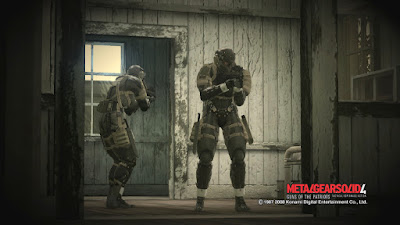
Regrouping on board the Nomad, Naomi Hunter begins to bond with Sunny, teaching her how to cook eggs and discussing science. She then gives Sunny a blue rose to wear in her hair. After this, she tells Snake and Otacon that Liquid is in Eastern Europe searching for Big Boss’s corpse. His genetic code and biometric data are necessary to gain control of SOP – in his two previous tests, Liquid had used his own DNA and Snake’s DNA to attempt to take control of the system, but both attempts had failed since neither of them were 100% genetic matches of Big Boss. She also reveals that Big Boss is not truly dead – his cells had been kept alive and his body was in a nanomachine-induced coma. Meanwhile, Raiden’s condition has worsened. Naomi realizes that he will need an infusion of artificial blood, which Raiden reveals can be acquired in Eastern Europe from a Dr. Madnar (possibly the same Dr. Madnar from Metal Gear and Solid Snake). Realizing that Big Boss’s body and the artificial blood are in the same area, the Nomad heads towards Eastern Europe to continue the mission.
During the night, Naomi speaks to Otacon, who has been working through the night. They discuss how their creations have been used for evil purposes. Otacon also tells Naomi about his step-sister, Emma, who had created the worm cluster which infected GW at the Big Shell. He also reveals that Sunny is the real computer genius amongst them – it was her who decoded Naomi’s heavily-encrypted transmission. After some flirting, the pair head to the helicopter, where Naomi pulls Otacon inside for some lovin’.
The next day, Snake heads into Eastern Europe to locate Big Mama, leader of the Paradise Lost Army resistance. Campbell promises that he will provide him with a way to get past the local PMC security forces from Raven Sword. Snake disguises himself with FaceCamo to make himself look younger and dresses in civilian clothes. When he refuses to go through an ID checkpoint, he is taken aside by Meryl Silverburgh and Rat Patrol, who have been deployed to the area to oversee PMC activity. She reveals that a US army detachment is in the city and are ready to come down on Liquid as soon as he makes a move. She tells Snake not to put his life at risk anymore and that she can’t stand to see him kill himself over something like this. Snake scoffs at this, leaving Meryl with some enmity between the two.
Heading out into the city after curfew, Snake locates a Paradise Lost Army resistance member and begins to pursue him while helping him evade Raven Sword PMC troops. After pursuing him through the streets of the city, the resistance member leads Snake right to Big Mama’s location. Snake bursts in and is confronted by Big Mama (aka, EVA), who reveals to him that she is her mother who gave birth to Snake and Liquid as part of the Les Enfants Terribles project. She explains to Snake the origins of The Patriots: they originally consisted of herself, Big Boss, Ocelot, Major Zero, Sigint (Donald Anderson) and Para-Medic (Dr. Clark). However, the organization soon split into two factions over their disagreement over The Boss’s will: one side led by Big Boss while the other was led by Major Zero. Big Boss had attempted to overthrow The Patriots in Outer Heaven and Zanzibar Land, while EVA and Ocelot, still loyal to Big Boss, had overseen the deaths of Para-Medic and Sigint just before/during the Shadow Moses incident. However, Ocelot had been lost when he grafted Liquid’s arm onto his body, with Big Mama believing that he was now a part of his own faction in this long conflict. Big Mama then shows Snake Big Boss’s body, loaded in the back of a van and ready to be evacuated.
The meeting is then interrupted by a group of Dwarf Gekko which reveal the resistance base to the Raven Sword forces. Big Mama, Snake and the Paradise Lost Army flee with Big Boss’s body as the PMC troops, led by Raging Raven, pursue them. Snake and Big Mama crash, with Big Mama receiving a serious injury as she is impaled in her side by a piece of metal. Snake heads into a tower to take down Raging Raven. After he defeats her, he returns to Big Mama to head to the riverside – Big Mama reveals that the vans had all been decoys and that Big Boss’s body was actually being evacuated on a boat. However, when they get to the boat, they find Ocelot waiting for them. He fights Snake, stabbing him with his own stun knife and electrocuting him as Snake struggles to stop him. Liquid gloats over his own success and then leaves in a boat, accompanied by Vamp and, surprisingly, Naomi.
Before Liquid can escape though, he is surrounded by US forces led by Meryl and Rat Patrol. Snake and Big Mama board Meryl’s boat as she orders Liquid to surrender. However, Liquid refuses and reveals that he has finally hijacked the SOP system by locking out all of the US soldiers’ weapons and remotely deactivating the circling helicopters. He then turns off all of the US soldiers’ emotion controls and then orders his FROG troops them down. The result is a massacre as many of the US soldiers are killed and Rat Patrol is badly wounded. Liquid then has Vamp throw Big Boss’s body into flames on Rat Patrol’s boat, incinerating it. Big Mama leaps onto the fire to attempt to save him, but it is too late. Liquid shoots Big Boss’s body in the head and triggers an explosion which mortally wounds Big Mama and leaves Snake with a horrific burn on the left side of his face. In the confusion, Otacon manages to sneak the Mk. II aboard Liquid’s boat as it escapes. Akiba also manages to save Meryl from drowning, for which he is rewarded with a thankful kiss. However, Big Mama succumbs to her injuries and dies.
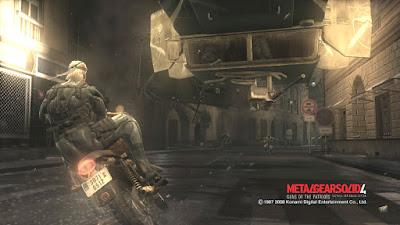
Using the Mk. II, Otacon is able to determine that Liquid plans to destroy The Patriots’ main AI, JD, which is disguised as space junk orbiting the planet. To do this, he needs a weapon that is powerful enough to fire a missile into space and a nuclear missile – SOP is not sufficient to do this, as all WMDs are controlled by JD, not SOP. However, the Mk. II is soon discovered and destroyed, prompting Otacon to construct the Mk. III as a replacement.
As Snake and Campbell debate how Liquid will be able to destroy JD, Otacon realizes that he will use Metal Gear REX, since its rail gun predates the implementation of SOP and is capable of launching a nuclear warhead into space. After confirmation from Mei Ling, who is now the captain of the WWII-era battleship U.S.S. Missouri, Snake pursues him to Shadow Moses island. Raiden attempts to join Snake, but Sunny protests, as his dialysis is still incomplete. Realizing that Raiden has a deathwish, Snake tells Raiden that he still has a life and a family, whereas Snake is going to be dead within a few months. Raiden angrily protests that he has no family before passing out once more.
Otacon then flies Snake to Shadow Moses via helicopter and drops him off just west of the heliport. Snake then makes his way to the heliport and is met with a rush of flashbacks as he views the decrepit state of the nuclear disposal base. Snake makes his way through the facilities, evading Gekko and Dwarf Gekko units from the Werewolf PMC in the process. After making his way to the snowfield where he fought Sniper Wolf for the second time, Snake is confronted with the Beauty and the Beast Unit member Crying Wolf, who fires at him with a miniaturized railgun. Snake manages to defeat Crying Wolf in the middle of a blizzard and then proceeds into the underground base to find REX. After making his way into the hangar, he finds REX where it had been left, but that its railgun has already been removed. He is then confronted by Naomi and Vamp. Vamp attacks Snake, but Snake injects him with a syringe given to him by Naomi which suppresses nanomachines, rendering Vamp into a mortal once more. As he does so, Raiden appears and fights Vamp while Snake battles a unit of Suicide Gekko who attempt to destroy the base. Snake destroys the Gekko as Raiden slashes open Vamp, leaving him horrifically wounded. Naomi then tells Otacon (via the Mk. III) to finish him off by injecting him with the syringe – as an act of mercy, not revenge.
With Vamp now dead, Naomi apologizes to Snake and Otacon for tricking them before revealing that she has been suffering from terminal cancer now for years which she has been using nanomachines to keep at bay. She injects herself with the syringe as an act of suicide, sorrowfully telling Otacon to continue to live his life. With more Suicide Gekko headed their way to destroy the base, Otacon uses the Mk. III to reactivate Metal Gear REX. Snake pilots the damaged mech and uses it to escape the collapsing base. Raiden, however, is trapped by the falling rubble.
As they reach the surface, Snake is suddenly confronted by Liquid, piloting Metal Gear RAY. The two Metal Gears battle, with REX managing to come out on top due to some clever maneuvering by Snake. Liquid scrambles from the wreckage of RAY and begins heading towards the ocean, while Snake painfully follows after him, having injured himself exiting REX. Before he can catch up with Liquid, an Arsenal Gear emerges from the sea – Liquid’s “Outer Haven”, now equipped with REX’s railgun and housing The Patriots’ hijacked AI, GW. When JD is destroyed, control of The Patriots will defer to GW, and at that point Liquid will have full control over The Patriots’ network. Liquid then tries to ram Snake with Outer Haven, but is stopped when Raiden, who cut his own arm off in order to escape from the rubble in the underground tunnel, puts himself between Outer Haven and Snake. However, the pier begins to crumble and Raiden is seemingly crushed as Snake gets out of the way. Before it can finish Snake though, the U.S.S. Missouri arrives and opens fire. Outer Haven retreats and heads out into the open ocean to prepare for the final strike on JD. Snake and Raiden, who somehow survived, are taken aboard the Missouri to make a final assault on Outer Haven.

Mei Ling briefs US military units, as well as Snake, Otacon, Meryl and Akiba aboard the Missouri. When Outer Haven surfaces to make its nuclear strike on JD, they will send a strike team aboard the submersible fortress and infect it with a worm cluster uploaded to the ship’s AI, GW. Using intelligence provided by Naomi Hunter, the strike team will catapult on board Outer Haven and then penetrate its server room, which is protected by microwave directed energy weapon. Once inside the server room, they would upload the virus developed by Naomi and completed by Sunny. Snake, Meryl and Akiba volunteer for the mission. Meanwhile, Drebin is also revealed to be on board the Missouri, providing the soldiers with weapons and the catapults that the strike team would use to infiltrate Outer Haven.
After Outer Haven surfaces, the Missouri commences a naval battle with Haven’s defences and Metal Gear RAY units, while the strike team is inserted into the ship. Akiba’s launch is unsuccessful though, which sends him plummeting into the ocean rather than inside the ship. Snake makes his way past FROGS and Gekko until he gets deeper into the ship’s core. Here, he encounters an injured Meryl and is forced to battle waves of FROGS. However, the last Beauty and the Beast Unit member, Screaming Mantis, appears and attempts to stop Snake. Akiba inexplicably arrives and fires at Screaming Mantis, revealing that her “psychic abilities” are simply a result of nanomachine manipulation. Utilizing this knowledge, Snake defeats her before being confronted by the ghost of Psycho Mantis. After showing off to Snake, his spirit is banished for good by the spirit of The Sorrow.
Snake then continues on to the server room. Meryl and Akiba decide to hold the inexhaustible supply of incoming FROGS back and buy Snake the necessary time to get to GW. As the pair battle, Akiba proposes to Meryl, claiming to have loved her ever since he had seen her on Shadow Moses (and stolen his uniform). Meryl refuses at first, but then turns things around and proposes to Akiba herself, which he accepts.
Meanwhile, Snake moves further into the core where he is surrounded by FROGS outside of the microwave corridor. However, Raiden appears (now completely armless) and tells Snake that he will hold them off for him. Snake enters the microwave corridor after outrunning swarms of Dwarf Gekkos and struggles towards the AI core as he is painfully bombarded by microwaves. Through force of will, he manages to reach the AI core where the Mk. III uploads the virus just as all hope seems lost.
With the virus uploaded, the FROGS suddenly lose their will to fight, Outer Haven is left totally defenseless, the RAYs attacking the Missouri are deactivated and the railgun is stopped from firing. A video of Naomi then begins to play on the screens in the AI core, where she explains that the worm, named FOXALIVE, used GW to penetrate The Patriots’ entire AI network, destroy all of the AI cores and disable SOP for good, effectively eliminating The Patriots in one blow. The Patriots had intended to extend SOP to the civilian population as well, at which point their control would have been universal. While Naomi believed that FOXALIVE would result in the end of modern civilization as key infrastructure was destroyed, it is revealed that Sunny modified her virus to preserve energy and resource networks essential to modern society. Snake passes out in the AI core before Missouri troops can come and extract him.
Snake later wakes up on the deck of Outer Haven where Otacon tells him that he will find medical assistance for Snake’s wounds. However, Liquid then appears and takes Snake to the highest point of Outer Haven. Liquid explains that he had always hoped that Snake would upload the worm, since now The Patriots were destroyed for good and Big Boss’s dream could now become a reality. He challenges Snake to one final hand-to-hand battle. The pair slug away at one another as Ocelot’s persona slowly begins to rise back to the surface through each repeated beating. Eventually, the two slowly beat on another to death as Snake gets the upper hand and fatally beats Ocelot to the point of death. Ocelot reveals that he was “Liquid’s doppelgänger” and then, reminiscing on his first meeting with Big Boss, tells Snake that “You’re pretty good”, before dying from his wounds.

In the game’s epilogue, the Nomad is used as a makeshift chapel for Meryl and Akiba’s wedding. Campbell and Meryl finally reconcile as he leads Meryl down the aisle. Otacon, Sunny, Mei Ling and Jonathan watch the wedding as Ed acts as the priest and marries the couple. Drebin then shows up, providing the couple with a shower of flowers and doves. As everyone parties, Drebin reveals that the “Drebins” organization of gun launderers were actually agents of The Patriots, used to keep the War Economy going. He was ordered to help Snake assassinate Liquid, although they had no idea that Snake would be used to inadvertently eliminate The Patriots. In addition, Rat Patrol were also inadvertently being used as Patriot agents. However, Drebin is happy to see The Patriots gone as it has given him freedom to create his own organization, although his fears that the UN might become the new “Patriots” as the collapse of the War Economy has sent many countries spiralling into deep debt. Sunny asks Otacon if she can give the Mk. III to a boy she met, her “first outside friend”, and asks Otacon where Snake is. Otacon evasively replies that Snake is sick and needs time to rest.
Meanwhile, Raiden recovers in a hospital, his cyborg body being replaced with one which resembles a human body more closely. Rosemary enters the room with a young boy, but Raiden at first refuses to speak with her. Rose reveals that her marriage to Campbell and her miscarriage were both deceptions used to keep her and their son, John, safe from The Patriots. Shocked, Raiden tries to reconcile with his son, who recoils at first, but then reveals that he thinks that his father is like a superhero. The three embrace and promise never to let one another go again.
Elsewhere, Snake visits the grave of Big Boss and prepares to complete his final mission. He draws his pistol and puts it in his mouth to end the threat of the mutated FOXDIE. The camera pans away as a shot rings out…
…however, as the credits begin to roll, it is revealed that Snake wasn’t able to commit suicide and fired into the air instead. However, he is suddenly confronted by Big Boss, who has somehow been brought back to life. Before Snake can react, Big Boss disarms Snake and then embraces him with a CQC hug. He explains that he has no intention to fight Snake. Big Boss reveals that the body destroyed in Eastern Europe was actually Solidus’. Since Solidus was actually a perfect clone of Big Boss, his genetic code had been sufficient to gain control of the system, whereas Liquid and Solid’s DNA was not a 100% match. He also explains that his body has been reconstructed using transplanted pieces from Liquid and Solidus. The destruction of The Patriots finally freed his consciousness from their nanomachine-induced coma and allowed Big Boss to return to life once more. Big Mama and Naomi Hunter had been instrumental to the deception that allowed Snake to destroy The Patriots, as they used The Patriots’ own attempts to defeat Liquid against them. Ocelot was also involved – he used nanomachines and hypnotherapy to trick everyone, including himself, into believing that he was possessed by the spirit of Liquid Snake, bent on wiping out The Patriots and bringing about Big Boss’s vision of Outer Heaven.
Big Boss also explains his history with The Patriots. When the worm moved from GW to the other Patriot AIs, it also revealed the location of the final Patriot, Zero. Big Boss then wheels Zero, now in a vegetative state, to Snake. Big Boss reveals that they will never be free of The Patriots until the last of its founding members is dead. He then shuts off Zero’s air supply and suffocates his old friend and bitter enemy to death. However, with Zero dead, this leaves Big Boss as the last founding member of The Patriots. Snake questions whether Big Boss will have to die next, to which Big Boss reveals that the FOXDIE implanted in Snake is already doing so – it already killed Ocelot and Big Mama, and will soon kill Big Boss as well. He also reveals that this FOXDIE strain will supplant the mutated one, meaning that Snake will no longer become a walking biological weapon, although if he lived long enough this strain of FOXDIE will also one day mutate.
Snake then carries Big Boss over to the grave of The Boss, where Big Boss salutes her one final time. He sadly reveals that he finally understands The Boss’s will: “It’s not about changing the world, it’s about doing our best to leave the world the way it is. It’s about respecting the will of others and believing in your own”. Snake and Big Boss share one last cigarette, while Big Boss tells Snake to spend the rest of his life living peacefully. After a lifetime of hatred, the two finally make peace. As he dies, Big Boss’ final words are:
In the game’s final post-credit scene, Snake meets up with Otacon. Snake explains that he has one more thing that he needs to do: he needs to see this age off and see what the future brings. Otacon agrees, telling Snake that he and Sunny have to pass on the memory of Snake to future generations.
GAMEPLAY & DESIGN
Guns of the Patriots marks, in a lot of ways, some of the most revolutionary changes to the Metal Gear gameplay formula in the franchise’s history. While the basic gameplay systems are very similar to Snake Eater, the game has undergone some significant refinements or completely different design philosophies to give it a more “modern” feel, making the game play significantly differently than previous games in the franchise. Leading the refined systems is OctoCamo, which replaces the bothersome menu-hopping in Snake Eater. Now, Snake’s camo changes automatically if he is stationary for about a second, making sneaking considerably less bothersome. In addition, the Cure menu has also been eliminated, making the game far less menu-intensive. The only major menu-headache is due to the limited backpack slots – you only get (I believe) 8 items at a time and only 5 weapons, meaning that you’re often forced to pause and swap out for a new weapon… especially during cutscene transitions, which will often swap one of your weapons out for an M4 or an Operator pistol.
Guns of the Patriots‘ other big addition is the refined control options. Whereas previous Metal Gear games were strangely archaic in the actions they allowed Snake/Raiden/Big Boss to perform, Guns of the Patriots really opens up the player control. Snake is now able to crouch-walk, roll around on the ground, aim in both first and third person modes and strafe while firing. This actually makes Guns of the Patriots the first game in the franchise where going in loud is actually a viable option, as the gunplay is very smooth and responsive, and Snake isn’t bogged down by imprecise aim or arbitrary control restrictions.
On the potentially more negative end of the refinements though, the Codec has been reduced to being basically irrelevant. Whereas previous games had used the Codec for story information or to provide hints, the Codec in Guns of the Patriots is basically useless. You only get a couple of channels with which to chat with Otacon about mission hints or to recover your psyche with Rosemary (and shake her boobs with SIXAXIS…). Personally I do not mind this change, as I had always found that parsing out story info to Codec calls made you have to waste a ton of time calling people if you wanted more background, or just made you skip over it entirely if you just wanted to beat the game. Personally, I prefer if the story is actually told in-game rather than being basically context-sensitive, although I do know that some people became really sad that the Codec was reduced in effectiveness here. Don’t worry though, it only gets more useless from here on out!
In addition to these refinements, Guns of the Patriots has some great new elements which enhance the gameplay. Snake now as a “threat ring” which is very useful for maintaining situational awareness and helps as the game lacks a persistent radar. The game also features the Solid Eye, which highlights enemies, provides a short-ranged radar (with sound- and sight-radiuses marked) and has built-in night vision goggles. However, if there’s one problem with the Solid Eye, it’s that it is so good that it makes most of the other items in the game practically worthless in comparison. Like, as much as I want to listen to the iPod in-game, doing so is going to gimp my gameplay significantly. That said, you can at least use the in-game camera in third person mode without using your one item slot, which is handy (and helped me to personally take many of the screenshots in this retrospective entry).
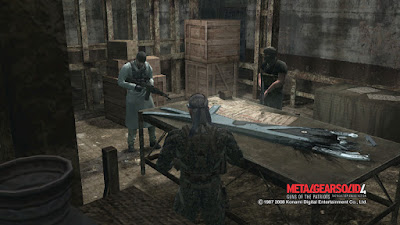
The game also introduces a ton of new weapons and customization. Drebin introduces a whole shop of weapons which the player can choose to experiment with at will, while also providing them with weapons and equipment and incentivizing risk to acquire “Drebin Points” to pay for these rewards. Guns of the Patriots also has a robust weapon customization system which allows you to equip many weapons with various scopes, sights, underslung weapons, grips, laser sights and flashlights. It’s a pretty impressive system and helps when you want to create “that one super-weapon” that defines you as a player.
Guns of the Patriots also shakes up the Metal Gear formula significantly by being the first game in the franchise to have more than 2 distinct areas. In fact, it has 5 distinct maps, spread out over the course of its 5 act structure. Compared to previous Metal Gear games, each area also tends to be significantly larger (both in terms of map size and layout) which means that there are far less loading screens. However, this is a double-edged sword, as it also means that you will likely lose a lot more progress if you die near the end of an area. These 5 areas also contribute to one of the most derided aspect of Guns of the Patriots: the mandatory chapter-by-chapter installs. When the game first launched, each time you enter a new act, you have to install the data for the mission, which takes about a minute every time it happens. This was always an annoying process, but with the 2012 patch, the game can now be fully installed on the HDD. I had done this previously and forgotten about it, but when I realized that I didn’t have to go through the chapter-by-chapter install for this playthrough, it made me quite relieved.
These more open environments help to facilitate the fundamental sneaking gameplay of Guns of the Patriots, which is very refined and modern. In the first 2 Acts of the game, the sneaking all takes place on active battlefields, which is very cool and extremely impressive. Rebel and PMC forces battle one another as you make your way from place to place, with the option available to help sway the battle in favour of one side or the other. Unfortunately, if you’re going to sway the battle then there is basically no incentive to do so for the PMCs, as they will shoot you on sight regardless, whereas the militia/rebels will choose to ally with you. Aiding the rebel forces becomes a whole game unto its own, as the rebel forces have their own objectives to achieve and won’t be able to accomplish without at least a little help from Snake. The only problem here though is that this warzone-based sneaking only really occurs in the first 2 Acts. That said, they are definitely the 2 strongest in terms of pure gameplay enjoyment.
While Guns of the Patriots doesn’t have nearly enough active-battlefield sneaking gameplay, it does shake up its own formula very frequently with many different kinds of gameplay twists. For example, early in the Middle East, Snake and Rat Patrol get into a shootout with the FROGS which plays like a straight-up third person shooter. Due to the new control scheme, this sort of scenario plays out much more successfully than similar action sequences did in previous Metal Gear games, such as the stair shootout in Metal Gear Solid. The game also features two very exciting vehicular chase sequences, which show off the game’s much more action-oriented set-pieces and improved shooting controls. There is also an interesting split-screen segment where you have to blow up Suicide Gekko with a railgun while Vamp and Raiden duel, which is fairly cool.
It’s not all about the action though. The game also throws in twists on the stealth gameplay at times. Act 2 features an extended sequence where you have to hunt down Naomi by following her tracks and avoiding enemy patrols. Acts 4 and 5 also are incredibly difficult to complete if you don’t rely on pure stealth to get you through. While this is enjoyable, it isn’t nearly as compelling and unique as the “battlefield stealth” of Acts 1 and 2. Act 3 is also an entire level of “gameplay twists”, as it emphasizes stealth in an urban environment as you tail the resistance member. However, this mission has been derided as one of the absolute worst levels of the last decade due to the shoddy design of the resistance member’s AI. Whenever he gets spotted, or he spots you, his pathfinding gets screwed up and causes him to backtrack, making this level potentially frustrating as he constantly gets knocked off of, and back onto, course. In this playthrough, I must have spent 10 minutes chasing the stupid bastard in a circle around a city block as I tranquilized guards in front of him, causing him to backtrack before advancing to other guards, forcing me to tranq them as well, etc. However, by the time he was done running in a circle, the guards I had tranquilized in the first place had woken up, causing me to literally run 2 circles around this city block before I just double-tapped all of the guards in the area to give the resistance member a bloody chance to get from point A to point B without breaking his pathfinding. It was a right pain in the ass.
There are also a couple gameplay twists which are notable for how good they are at developing the story. One such case is the inclusion of the helipad sequence from Metal Gear Solid just before beginning Act 4 to help drive home the nostalgia of the story. There is also the button-mashing sequence in the microwave corridor which, thankfully, is super forgiving. It requires a solid minute or two of button mashing, but even I was able to complete it with no problem, and the pain it induces it clearly meant to parallel the pain being suffered by Snake himself.

It’s also worth pointing out that the graphics in Guns of the Patriots are still quite good, even 7 years removed from its release. In fact, despite being an early PS3 game, its graphics are still very good in comparison to many games from later in the PS3’s lifecycle (and arguably better than some modern games, such as Fallout 4). Most of this comes down to the character models, which are fantastic. The environments are much less impressive, with much lower-resolution textures, but the game compensates with a variety of atmospheric filters which make them look very stunning regardless. This is most clearly demonstrated in Acts 3 and 4. In Act 3, the entire environment is saturated with stark contrast and a bloom effect which gives off a film noir effect. Act 4’s return to Shadow Moses uses a blue filter and some impressive ice effects to both call back to Metal Gear Solid and demonstrate the harsh nature of the area. The environments of Act 4 in general are actually very well detailed and is one of the highlights of the game as you get to see most of Shadow Moses remastered in HD.
The problem with this though, in addition to the chapter-by-chapter installs, is that the game’s framerate tends to be wildly inconsistent. The framerate tends to hover around 30 fps at best, but whenever there are explosions or some other graphically-intensive event on screen, it will dip very noticeably. It doesn’t make the game unplayable by any means, but it is a performance issue which no previous Metal Gear really had to deal with and is especially prevalent during certain sequences, such as the Act 3 motorcycle chase.
In order to get to the gameplay though, players will have to wade through an insane amount of cutscenes. The very opening of the game gives you a good idea of how the game is going to play out as you watch a cutscene, take a few steps, watch another cutscene, take a few more steps, watch another cutscene, then get a couple minutes of rather intense stealth gameplay… which is then capped off by another 5-10 minutes of cutscenes. That said, cutscenes which occur in the middle of a mission do tend to be quite brief unless they serve some sort of very important story purpose, such as Snake and Naomi’s meeting in Act 2 or Big Mama explaining the history of The Patriots in Act 3.
The cutscenes start getting noticeably longer by the beginning of Act 3 though: just to start Act 3, you have to endure about 40-50 minutes of cutscenes and then there’s even a 60 minute sequence of cutscenes between the end of Act 3 and the start of Act 4. That’s not even the worst of it, as the game’s epilogue hold a world record for featuring a whopping 71 minutes of cutscenes to tie up the last of the franchise’s storylines. Guns of the Patriots also introduces pre-mission briefings which are technically interactive, but which are basically just overglorified exposition-dump cutscenes when all is said and done. They do help contextualize the upcoming mission well, but they are also a prime contributor to the glut of cutscenes in the game.
Now, with all of this said, the cutscenes are very well-directed and tend to be fairly interesting, although they do tend to be very exposition-laden. The option has also been added to pause cutscenes, which really helps when you need to take a bathroom break in the middle of an hour long sequence. The game also features multiple save breaks in the middle of some of these sequences as well, which is very thoughtful and suggests that Kojima and company were aware that they were going to be an issue for people. The thing is though that the game is only going to take you around 16 hours to complete, and around 2/3 of that playtime is comprised of cutscenes. In fact, after skipping cutscenes, I have beaten the whole game before completely undetected in about 3.5 hours in order to get ahold of some of the special emblems. This is actually close to being on par with previous Metal Gear games actually, but it’s still distressing that even the bulk of a first playthrough is going to comprise of cutscenes rather than gameplay. I think that it would be fair to say that Guns of the Patriots emphasizes cutscenes and story to the detriment of the gameplay.
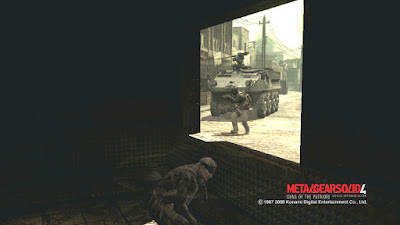
The difficulty of enemy soldiers is going to come down to your difficulty setting. For this playthrough I chose to play on Big Boss Hard, and was actually surprised by just how aware enemies were. Even the basic enemies have reasonably long sightlines in which they can see Snake if you’re not being especially cautious, prompting them to investigate. They can also pick out your footsteps, making hold-ups and CQC difficult to pull off if you’re too daring. It’s also worth pointing out that many regular soldiers look different from one another based on their role, not to mention that their character models all change from mission-to-mission based on the PMC they are a part of (which is probably why they are phased out after Act 3). The FROGS (aka, Haven Troopers) are similar to regular soldiers, but with improved armour, senses and mobility. They also have a very cool and unique design which is (in my opinion) on par with the Storm Trooper uniform in terms of its iconicness. In the latter-stages of the game, FROGS replace regular soldiers, helping to up the difficulty in a natural way.
In addition to the regular mooks, Guns of the Patriots also features a few unique, unmanned enemy types which you will have to face off with on a regular basis. Most prominent among these are the Gekko units. These pseudo-Metal Gears are really intimidating the first time you see them – they have a fantastic introduction, unique design, a really iconic theme tune, a strangely unsettling “moo” call, and are very deadly if they detect you. Their main cannons can stagger Snake and take off quite a bit of damage in the harder difficulties. If they’re blocking your path, which they often are, their “leg sweep” attack can also knock off 75% of Snake’s health in one hit, making them incredibly difficult to take on in a one-on-one battle. There are also enemies called Dwarf Gekko which appear starting in Act 4, which are very annoying to encounter. They’re not particularly dangerous on their own, but they always appear in swarms. If they detect you, they will come at you in droves. They seem to respawn during alerts, meaning that if you try to destroy them all, more will just keep coming. When facing off against Dwarf Gekko, it seems that the best strategy is to remain undetected and to just run if spotted. The game also has a few one-off enemies, such as the flying “Slider” drones, a LAV, a tank, some jeeps and even PMC troops in an armoured exoskeleton (a la Ripley in Aliens).
Unfortunately, after some of the most stellar boss battles in the franchise’s history with Snake Eater, Guns of the Patriots features a rather hit-or-miss selection of boss fights. In fact, while Portable Ops can be forgiven for its limited hardware and disposable nature, Guns of the Patriots really marked a trend of decline for the series’ boss battles, which would never again reach the heights that the series had been known for in the past. This is not helped by the fact that the game’s “boss squad”, the Beauty and the Beast Unit, have basically no personality and are just a transparent amalgamation of enemies from previous games defined by a single emotion. All of the Beasts also have a “Beauty” form, which always plays out the same way – a supermodel will emerge from their exoskeleton and pursue Snake for about a minute before dying automatically (if not shot first, although they seem to have a 50% chance of dodging all incoming bullets). These encounters are interesting the first time they happen, but each subsequent encounter gets boring quick as they are all the exact same.
The first battle in the game is in Act 2 against Laughing Octopus, which is fairly interesting. The fight itself is pretty boring (basically a stand-up shootout for the most part), but what makes it interesting are Octopus’ hiding spots and mimicry attempts. You spend most of the “fight” trying to figure out where she is hiding, and there are lots of devious places where she does so. It seems that her spots are randomized every playthrough as well, so you probably won’t even see them all the first time you beat her – I know that she didn’t utilize at least a couple of hiding spots during this playthrough, so she was always keeping me on my toes. She can get fairly frustrating though on higher difficulties, as her tentacles can kill you in 2 hits and her rolling attack will knock off 75% of your health with very little time to get out of the way of it. I was getting really frustrated because the fight itself was proceeding very easily, but then she’d suddenly kill me out of absolutely nowhere due to these extremely high-damaging attacks. Still, it is a very unique encounter, and definitely one of the best bosses in the game.
Next up is the Act 3 battle against Raging Raven, which is pretty poor. Raven basically just strafes your position and fires her grenade launcher every once in a while. She’s also quite a bullet sponge – I went through all of the ammunition in my M4 twice just to kill her Beast form. The only real test is avoiding getting blown off of the roof by her grenade launcher (which is totally random) and spotting her in the first place (she is surrounded by Sliders, which resemble her quite a bit). As a result, the battle boils down to “shoot her until she dies, and don’t get shot yourself”, which is just boring. It also doesn’t help that she has a really annoying personality, as she spends the whole fight yelling “RAGE! RAAAAAAGE!!!” over and over again. She must have taken some lessons from Khorne.

One of the best boss battles in the game is the sniper duel between Snake and Crying Wolf out on the Shadow Moses snow fields in Act 4. This battle is clearly meant to homage Snake’s second battle with Sniper Wolf, but I personally think that it bests that battle in terms of its gameplay. For one thing, the shooting controls are so much better in this game that you can actually reasonably partake in a sniper duel without having to resort to nikita missiles to cheese your way through. In addition, the game’s graphics are better able to sell the idea of this being an epic showdown in the middle of a blizzard. To make matters even better, there are also FROGS present during the fight which are constantly hunting you down and the cold is constantly biting away at your stamina bar, making this a very tense battle. There are also some interesting twists, as Crying Wolf can catch your scent if you’re downwind, and she is only vulnerable if she exits her exoskeleton or if you shoot off one of her two grenades. All-in-all, it’s a very fun and tense sniper duel which not only successfully homages one of the great battles from Metal Gear Solid, but actually improves upon the battle itself.
Unfortunately, it is then followed up by a battle with Vamp shortly after, which is easily the worst boss battle in the whole game, and easily one of the worst in the entire franchise. Despite being a pretty awesome villain, Vamp spends the entire battle just hopping from platform to platform while you pump him full of bullets. Occasionally he’ll jump down and perform an easily-dodged attack or throw some knives at you, but these attacks come surprisingly rarely, even on Big Boss Hard. On subsequent playthroughs, this fight becomes even more of a joke if you manage to unlock the solar gun, which can one-shot Vamp. The only “challenge” in the fight is figuring out how to finish off Vamp. This is actually kind of an annoying puzzle as I’m sure I’m not the only person who had no idea that the syringe could be used in CQC. Once you are aware of this trick though, the fight becomes a joke.
However, this is shortly followed up by a Metal Gear REX vs Metal Gear RAY fight to cap off Act 4, which is awesome. It is moderately annoying for introducing a completely new control scheme and attack methods out of nowhere, which means that you’re probably going to die once or twice just getting used to handling REX. When you get the hang of it though, this becomes a really fun and unique battle that fulfills many a Metal Gear fan’s dreams.
The final Beauty and the Beast Unit battle is in Act 5 against Screaming Mantis, which is clearly just an extended Psycho Mantis homage. Unlike Crying Wolf, this battle is not nearly as good, both as a homage and just in general gameplay. The fight is essentially one long puzzle as you first inject yourself with the syringe and then try to shoot off Mantis’ dolls. The fight then ends once you use her doll to tear off her armour. It’s pretty simple, but the homages are overbearing throughout the fight – we’ve got the HIDEO 1 screen, Meryl trying to shoot you/herself and even an appearance by the spirit of Psycho Mantis himself, who ends up being the actual force behind the Beasts inexplicably (which tramples on his sorrowful death in Metal Gear Solid).
Finally, the game ends with a one-on-one fight fight between Snake and Ocelot on top of Outer Haven. Similarly to the REX vs RAY fight, this is reasonably annoying for introducing completely new gameplay concepts out of absolutely nowhere, playing more like a very simple fighting game rather than Metal Gear. It also fails to explain a very crucial strategy that is basically required to win the fight on higher difficulties, that you can hold triangle during a taunt to restore health. That said, the fight itself is extremely brutal and epic in equal measure as the franchise’s biggest hero and biggest villain settle their scores once and for all. Despite introducing completely new concepts to the franchise at the very last moment, it’s a fantastic battle and easily one of the greatest moments in the whole franchise.
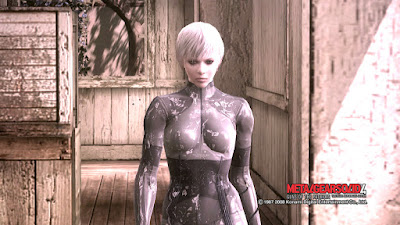
STORY & CHARACTER ANALYSIS
More than any previous Metal Gear game, the enjoyment that one will get from Guns of the Patriots is tied heavily to their previous investment in the franchise’s story. This is because Kojima has very intentionally tried to wrap up all of the series’ dangling plot threads which, if you are a fan, is an extremely daunting task. As a result, Guns of the Patriots is very much a fans-only release. I can remember when the PS3 was still early in its lifecycle and a co-worker asked if there were any good games out for it yet. I wanted to say Guns of the Patriots, but I knew that if they hadn’t played any (or ideally all) of the previous games before then they would be absolutely lost. However, if you are a fan, then Guns of the Patriots is arguably the best ending that anyone could have asked for. Miraculously, it manages to wrap up the franchise’s numerous storylines very definitively and in a very satisfying manner. In fact, it manages this so well that it actually makes the stories of previous Metal Gear games stronger in retrospect (in particular, it makes Sons of Liberty actually make sense). This is even more of a miracle when you remember that the franchise was put together piecemeal during each new game.
The game’s main theme is supposed to be “SENSE”, but it is probably best described with the idea of a person’s “will” (dammit Kojima, stop trying to make a theme for your themes). This is most clearly demonstrated through the conflict between Zero and Big Boss, which sprang out of differing interpretations of The Boss’s will, and which ended up shaping the lives of countless people over the decades that the conflict boiled. It is quite symbolic that the history of Big Boss and The Patriots is explained by Big Mama (aka, EVA) inside of a church, with numerous allusions being made to religion. Whether anyone wants to admit it or not, all religions are very much built upon a system which attempts to interpret the “will” of the god(s), prophet(s) or holy text(s) which comprise their belief system, which is then further interpreted by individuals. Any religious person can tell you that all religions are full of countless factions which form from people interpreting the “proper” will of their deity in different ways and with different levels of zealousness about the righteousness of their cause. The link between The Boss’s will and religious belief is very much intended to be a clear allegory.
Of course, both Zero and Big Boss failed to truly comprehend The Boss’s will. For Zero’s part, he believed in worldwide unity through total control, and idea which he attempted to pass on to his AI networks. However, the AIs were unable to properly interpret Zero’s will – they continued to try to maintain control until they realized that they could use war to achieve this end, which ended up plunging the world into the War Economy. This downfall actually mirrors the history of The Philosophers, whose own will to unite the world peacefully failed as soon as they passed their wills on to their children, which led to the Cold War. For his own part, Big Boss spends his life fighting to protect his own interpretation of The Boss’s will, but fails to truly understand her will until he is on his own deathbed. Ultimately, these opposing wills are used as ideologies from which conflict flows.
Guns of the Patriots also places a strong emphasis on the idea of the commodification of war. The game’s opening TV channel cinematics portray a world which is very strange, a world in which our sense of “morality” has been eroded to the point where a disembodied, cyborg head acts as a gameshow host, where war is an everyday part of peoples’ lives, and where private military corporations have their own super-flashy advertisements during prime time. The War Economy as presented in the game is a pretty fascinating concept, where most of the world’s militaries are outsourced to private contractors. Rather than fighting to further an ideology (or a “will”, you could say), they fight for nothing more than a profit. Rather than honing their skills over the course of a lifetime, soldiers now gain all of their skills from nanomachines, which suppress PTSD and prevent soldiers from committing war crimes. However, due to interference by The Patriots, the War Economy ends up becoming a driving force for the world’s finances, meaning that war is suddenly no longer an evil means to an end, but rather a driving force of the capitalist system. Already, in a lot of ways, war does have this sort of economic effect, although it isn’t exactly at the point where it is the driving power behind the entire worldwide economic situation. While it is presented in a sci-fi setting, it is very much a concept which has relevant parallels.
The manufactured necessity of war is something which seems to affect many of the characters very seriously. For example, when SOP’s emotion controls are suddenly taken away, the soldiers are suddenly confronted with all of the emotions they had experienced in combat, causing men to literally die as they get overloaded with massive amounts of PTSD. For them, war has been nothing more than a game until the reality of it all hits them at once (a statement obviously intended to parallel the players’ own experiences playing war games). The Beauty and the Beast Unit is also intended to tie into this – each of them were an innocent casualty caught up in the collateral damage of war which broke their psyche beyond repair. With so many conflicts spanning across the globe, it is implied that each of them is a direct product of the evils perpetuated due to the War Economy.
Interestingly, when Liquid hijacks the SOP system, many of the characters panic about what this will mean for the world economy, as his actions have unexpectedly led to the first global ceasefire in human history. The hypocrisy of these statements was really staggering to me, as world peace is a lofty goal which we could only hope to achieve in reality. When world peace comes with a dollar sign attached to it though, the world’s governments are thrown into a panic.
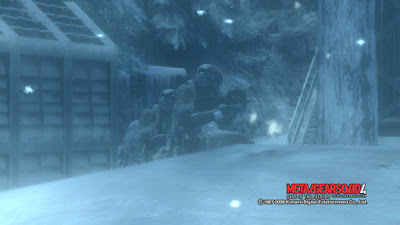
Guns of the Patriots also significantly expands on the concept of moral ambiguity which the series had been introducing ever since Sons of Liberty. A great number of the franchise’s villains are either exonerated or at least partially justified in their actions by the time that the game ends, while even the heroes are given shades of grey. The franchise’s most clear-cut evil villains, Big Boss and Liquid Ocelot, both end up being redeemed in the player’s eyes by the time that the credits roll, although their respective actions were still quite monstrous. Liquid Ocelot in particular is quite the enigma – over the course of his appearances, he is personally responsible for the deaths of countless individuals, but he also brings about a worldwide ceasefire and conspires to end the control of The Patriots and the War Economy. One could argue that he was making necessary sacrifices to reach an ideal ending which would save far more lives, although I would still argue that he is very much an evil man… just one who is far more sympathetic than we had been led to believe.
The identity of The Patriots also ties into this theme. Their identities actually caused a minor controversy back when this game came out. A lot of people have complained that it was completely ridiculous that the big villains of the entire franchise were the “comic relief” from Snake Eater, but I personally have the feeling that this was always intended to be the case. Between Portable Ops and the parallels shared between the downfall of The Philosophers and The Patriots, I actually think that the idea was to show that the people who founded The Patriots were good people who did so with the best intentions. However, the corrupting influence of unlimited power eventually turned them into monstrous individuals. Such an idea actually fits into the themes of Guns of the Patriots quite well. The only issue is that we lacked the context to really understand such an ideological shift (unless you played Portable Ops), but the foundations definitely seemed to be there to me.
The game also recontextualizes Solid Snake to make all of his “heroic actions” into unwitting actions which were allowing The Patriots to continue to dominate the world. Outer Heaven, Zanzibar Land and Shadow Moses were all intended insurrections against The Patriots by Big Boss/Liquid Snake, but Solid Snake was used as an unwitting tool to maintain their power. This twist actually works quite well and shows that Snake was never really in charge of his own destiny. You’d think that
that twist would piss off some of the fans, but it seems to have been accepted fairly well.
In addition to its themes, Guns of the Patriots also has some great narrative moments which make it an absolute joy for fans to experience. The plot sets up a lot of “rules” early on (such as the exact methods required to break into The Patriots’ systems), which are then cleverly subverted using pre-established story elements from previous games. The game also has a ton of fantastic moments which rank amongst the best in the whole franchise, either due to their strong narrative impact and importance to the overall storyline, or just because they’re freaking awesome. For example, Raiden’s introduction as a cyborg ninja was so cool that it launched a whole game, the REX vs RAY fight is extremely awesome, as is Solid Snake’s final fist fight with Liquid Ocelot, and Snake and Big Boss’s final reconciliation at the grave of The Boss. The game also just has some great plot beats: for example, Act 3 culminates with a series of huge twists as Liquid brutalizes Snake, leaving him permanently maimed, Big Mama dies trying to save “Big Boss”, Liquid succeeds at gaining control of SOP, massacres a unit of US marines, and then leaves the supposedly insurmountable Patriots in a vulnerable position for the first time in the franchise’s history. It’s moments like this which really make Guns of the Patriots enthralling to experience (even if they are rather long-winded at times).
However, the game’s heavy emphasis on narrative does not come without problems. One of the more cringe-worthy elements is the excessive use of scatalogical humour early on in the game, generally based around Johnny “Akiba” Sasaki. In his introduction you literally find him shitting profusely inside of an iron drum (with his ass showing for comic effect). He then proceeds to shit his pants in the middle of a firefight, with his pants comically stained brown for the rest of the battle. There are also a few different instances where Snake can come across enemy soldiers pissing, including one instance where the soldier can actually piss on Snake. I’ll admit, these moments did make me chuckle from the ridiculousness of it all, but it’s not hard to argue that the game would probably have been better off without this, especially since it tries hard to make Johnny into a heroic figure later on.
Oh, and also you can tear this statue’s dick off if you touch it too many times.
The game also has more plot holes and inconsistencies than most other Metal Gear games do, mainly by the sheer nature of trying to tie up so many disparate storylines. For example, how the hell did Meryl, Jonathan and Ed not realize that Akiba had no nanomachines? Was it not strange to them that they couldn’t share their senses with them? Does this work like in MGO where they had to manually link with him to share SOP, but were left thinking that he just refused to link?
Also, there’s a really odd retcon where Raiden suddenly is changed to actually being a member of FOXHOUND serving under Roy Campbell, even though in Sons of Liberty he admits that he has never actually met The Colonel. It was always implied to me that he was being pulled around by AIs and that FOXHOUND was disbanded, but with this inconsistency we’re suddenly led to believe that Raiden might have actually been a legitimate FOXHOUND soldier, but one who never personally met Campbell, having to switch between the real one and an AI at times in all likelihood. It’s a confusing inconsistency, although the only really major one in the game thankfully.
The Solidus-Big Boss switcheroo in Act 3 was actually a pretty brilliant twist, but by the time it is revealed, it makes Big Mama’s sacrifice not make a lot of sense. Big Boss explains that she was aware of the switch, so when she leaped onto the fire to save the body, was she merely doing this for show? It’s possible (she did think that Ocelot was totally rogue at this point so she might have done so for appearances), but hard to justify. Similarly to Psycho Mantis, Sniper Wolf and Vulcan Raven sacrificing themselves pointlessly, it seems like this is a plot element Kojima wanted to introduce for impact and then involve in another twist long after the player would have forgotten the exact details.
Finally, the justification tying Shadow Moses back into the plot is quite clever, but it also doesn’t make a ton of sense. I mean, as the owner of a series of PMCs, couldn’t Liquid have afforded to just build his own railgun rather than go to the trouble of stealing REX’s? The game claims that the manufacturing and operation of WMDs, such as this railgun, are controlled by JD rather than SOP, but we also see that Crying Wolf fires a miniaturized railgun, so he clearly has the technology necessary to construct one. Furthermore, Liquid was the one who leaked the plans for REX to the public in the first place, so he clearly knows how to build a railgun for himself. Are you telling me that he lacks the funds and trust to get someone else to build one for him? Is he afraid of a Patriot agent infiltrating his manufacturing and putting an ID lock on the weapon? The fact that there are also nuclear weapons lying around on Shadow Moses is also kind of hard to believe, you would think that the US government would have done something about this long ago or at least put the island under guard once again. The only justification I can think of is that Liquid’s plans might have changed after Act 2, which prompted him to get a railgun and nuclear weapon at short notice. Don’t get me wrong, Guns of the Patriots concludes the franchise with aplomb, but it introduces a lot of plot conveniences in order to get there.
In addition to its plot holes and inconsistencies, Guns of the Patriots also features some rather stupid plot elements which drag it down somewhat. One of these is the half-assed attempt to demystify some of the magical elements of the franchise. Foremost amongst these is Vamp, whose abilities are handwaved away as being the result of nanomachines. This is supposed to make things make sense, but unfortunately it fails to explain how Vamp is able to walk around on water, pin down your shadows, super-jump or run on water (especially since injecting him with the syringe only removes his regenerative abilities, the rest of his powers still remain). It’s a failed plot device which ends up coming across as “Kojima’s midichlorians” in a lot of ways.
There’s also the moment which I have famously stated might be one of the stupidest narrative moments in the whole franchise where Raiden stops Outer Haven, a gigantic Arsenal Gear, with nothing more than his body… even though the ground he’s standing on his crumbling beneath him. It’s completely idiotic and the height of the over-the-top moments in the game. You can’t even justify it with “magic realism” or “sci-fi technology” either, because we’ve already seen Raiden struggling just to keep up with simple Gekkos – are you telling me that somehow he’s now able to hold back a gigantic battle fortress which previously wiped out multiple city blocks in Manhattan? Or what about the fact that the pier Raiden’s standing on his crumbling, to which he stabs his own foot, which somehow stops him from losing any ground? It’s just an idiotic moment which makes me shake my head every time I see it, especially because Raiden ends up surviving being crushed anyway, making the whole sequence absolutely pointless.
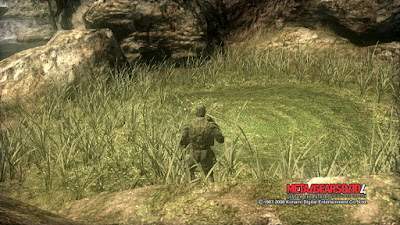
Series fans will be happy to learn that nearly every major character from the previous games makes an appearance or are at least referenced. The only exceptions are most of the characters from the first 2 Metal Gear games and, for some disappointing reason, Nastasha Romanenko. Foremost amongst the characters though is “Old Snake”, which is easily my favourite portrayal of Solid Snake. In fact, it is my personal opinion that Solid Snake never really came into his own until this entry. His advanced aging makes him very unique amongst video game protagonists, while also have some very major impacts on both the gameplay and the narrative. Ever since the end of Metal Gear Solid, Snake has been a force of optimism, but his advanced aging seems to have caused him to become disillusioned and somewhat of a nihilist. This is symbolized by Snake’s smoking throughout the narrative – people constantly chide Snake for smoking as it will one day kill him, but he doesn’t care as he knows he is going to die soon anyway.
Throughout his journey, Snake is focused simply on completing the last tasks he has been assigned before he dies. Initially, this starts with finally defeating Liquid once and for all, but as the plot progresses he realizes that he will have to end his own life. Having FOXDIE make a resurgence which will turn Snake into a walking biological weapon is a pretty great twist which makes the game’s nihilist tone in the early chapters hit harder. Snake has spent much of his life fighting back against the perception that he is not a person, but rather a weapon created in a lab, but this revelation simply escalates him to a literal weapon of mass destruction. Attempting to complete his final tasks takes a heavy toll on Snake. By the end of Act 3, he has become an absolute wreck pushing himself to the verge of death, but who simply fights because it is the duty he has assigned himself. As he states to Raiden, “We started this. And it’s our duty to finish it”. It’s only through sheer force of will that Snake is able to complete his missions, but he falters at the very end, finding himself unable to commit suicide.
Luckily, the timely intervention of Big Boss finally allows Snake the ability to reacquire his lost sense of optimism as he discovers that he will not become a living biological weapon anytime soon. Reintroducing Big Boss at this juncture was a rather insane decision, but luckily it works quite well. Especially considering that he really is the second “hero” of the series, it is very appropriate that he would get his proper conclusion in the series’ finale. As a result of this unexpected reunion, Snake and Big Boss both get their “happy” endings – father and son reconcile after spending much of their own lives trying to kill one another, while Big Boss orders Snake to spend the rest of his life in peace. This gives Snake one last purpose in life, to see the end of his era off and to help build a better future. This is symbolized by the fact that he stops smoking in the game’s post-credits sequence, having found something worth living for beyond his mission. It’s a very hopeful and fitting end for the series’ main heroes, both of whom finally find the rest that they had so long wished for.
Unfortunately, the series’ third protagonist, Raiden, really becomes insufferable in Guns of the Patriots. While he gets to pull off some insanely awesome action sequences, Raiden’s personality has regressed considerably from where it was in Sons of Liberty. I know that most fans think that Guns of the Patriots redeemed Raiden as a character, but personally I much preferred him in Sons of Liberty, especially by the ending. In this game, he is significantly whinier than he ever was before. Whereas Snake loses his optimism because of his own imminent death, Raiden loses his optimism due to Rose’s miscarriage and then his own inability to face the situation, which causes him to just run away from all of his problems. This actually just makes things worse, as he gets captured by The Patriots and turned into a cyborg, his original body reduced to little more than a jawless head and his spine. It’s a pretty disturbing fate, but one that Raiden wouldn’t have endured if he had been willing to just talk to Rosemary rather than run away from all of his problems.
Throughout the game, Snake tries to get Raiden to reconcile with Rosemary, but Raiden refuses to even acknowledge that she exists. He even attempts to volunteer for a couple different suicide missions in order to end his self-imposed “suffering”, to which Snake constantly tells Raiden to get some perspective. While Snake has no future, he insists that Raiden has a family and his youth to live for, but Raiden refuses to acknowledge either of these facts. When he gets crushed by Outer Haven, Raiden seems to momentarily realize that he does still love Rose, but this is immediately forgotten the next time that we see him as he tries to commit suicide again. Even in the ending when he finally reunites with Rosemary, he refuses to even acknowledge her presence until she tells him that she didn’t miscarry, that she still loves him and that they have a son. At this point, Raiden finally realizes that he has been a complete idiot for the past few years, and finally reconciles with his family, realizing that they are the most important thing in his life. If nothing else, at least this is a happy ending and we can assume that Raiden finally grows the hell up this time… right?
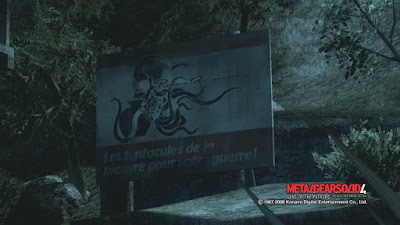
Liquid Ocelot also makes for a pretty great villain. This is mainly due to his importance to the series as a whole, which lends a lot of power to his portrayal. He’s a rather great, cackling, over-the-top villain who revels in theatrics. His chronic backstabbing disorder is also in full effect, with the rather insane revelation that his was merely faking being possessed by Liquid Snake’s arm in order to fool The Patriots into destroying themselves. It’s… pretty elaborate, but at least it’s better than psychic arms, right?
It’s also nice to see Meryl make a return, and she’s pretty damn badass. She doesn’t actually get to do all that much within the plot, as most of her actions end up getting foiled by the villains in one way or another, but she does have some great interactions with Snake and has a distinct presence within the story. She’s also super imposing – usually this sort of action heroine will be very conventionally beautiful and visibly incapable of actually winning a fight (see Waif-Fu), but Meryl is jacked. She could probably steal your lunch money if she wanted to.
On the flipside, the game introduces Akiba as a completely inept soldier, but then fails to convince us that he could possibly perform a 180 degree turn and suddenly become a super soldier. Meryl falls in love with him out of absolutely nowhere and then the two of them start gunning down FROGS in perfect synchronicity inside of Outer Haven in one of the corniest sequences in the entire game. Like, this just makes no sense from what we’ve seen of Akiba – he doesn’t just fall behind the others, he is also demonstrably an idiot, as he fails to turn the safety off his gun, alerts the PMCs to their position and nearly blows Snake’s cover at the Eastern Europe checkpoint. Having Meryl and Akiba get married is a pretty ridiculous conclusion to both of their storylines. Personally, I would have just been happier if Johnny Sasaski remained a goofy cameo-character rather than a full-blown major character of his own in this entry.
Oddly enough, Sunny Gurlukovich is probably my favourite new character, and is easily the best female character in the whole game. As those who played Sons of Liberty will know, she has a really tragic backstory as an orphan kidnapped by The Patriots who never actually met her mother. During the nights, she searches the Internet for information on Olga, hoping to finally understand the mother she never had. It’s actually rather heartwarming when she begins to bond with Naomi Hunter, as she finally gets a mother figure who she can share her interests with. She is also someone who has spent their life viewing the world through a computer screen, rather than experiencing life personally. This intimate knowledge of computers actually comes in handy, allowing Sunny to perform advanced technical feats, while also creating the virus which allows The Patriots to be destroyed while preserving modern society. As a result, The Boss’s will is finally accomplished and Sunny essentially becomes one of the biggest heroes in the entire franchise. By the end of the game, she finally steps outside of the Nomad and immediately makes friends with a foreign boy, despite the two of them not sharing a common tongue. She has a pretty fantastic character arc, especially considering that she’s only 7 damn years old and a secondary character within an action game!
Unfortunately, pretty much every other female character is severely mishandled in one way or another. Naomi Hunter is decent for her medical and scientific expertise, as well as her unclear motives which help to bring about the downfall of The Patriots. However, Kojima can’t help but make it so that she doesn’t know how to zip up her shirt, baring quite a bit of cleavage for pretty much the entire game. It’s not even just a single instance, she has a couple different outfits which are identical, and Kojima takes a few different opportunities to focus our attention on her cleavage. She also pulls off a pretty big dick move by getting into an intimate relationship with Otacon, despite knowing that she has terminal cancer and is going to die soon. She could have at least let him know… Ultimately, her death is quite sad, but I found that this is mainly because it makes Otacon sad, rather than because I felt bad for her in particular.

The rest of the female characters are worse. Rosemary is absolutely useless to the plot and feels like she was only brought back as a token reference and to let you use SIXAXIS to jiggle her breasts (seriously…). Her lying about miscarrying was also a MASSIVE dick move which causes Raiden no end of suffering. Mei Ling serves a similar role, basically just showing up to be sexualized by Akiba (who literally tries to grab her ass during a briefing). I mean, she’s a ship’s captain and seems to take the role very seriously, but Johnny still tries to grab her ass and stares at it the whole time they’re together. You could argue that this is just because Akiba’s an idiot, but Kojima has been trying to make him a big hero at this point, so that doesn’t make a lot of sense as something other than a supposedly “funny” gag. Big Mama also is kind of strange. For one thing, having an elderly woman baring her cleavage is actually quite progressive in some ways and doesn’t seem to be nearly as fan-service-y as many of the other questionable design decisions in the game, but her presence basically boils down to little more than an exposition dump and then fridging to drive the rest of the game onwards.
The Beauty and the Beast Unit is probably the absolute worst offenders though. They completely lack personalities outside of their one-dimensional emotion and it is very clear that they exist for little more than fan service, with any other considerations just tacked on after the fact. Their Beauty phases in particular are 100% fan service as they serve little purpose other than to pan the camera over the Beauties’ tits and asses in their skintight suits (and remember, these scenes were originally supposed to be of naked women). You can also take photos of the Beauties, in which they will actually pose for you if you wait long enough in the fight. Each of the Beauties is also based on a real-world supermodel, making it incredibly obvious that Kojima was just taking advantage of his position to hang out with models all day for his “work”. The game does try to get you to sympathize with them, but this does not occur until after you have defeated them, at which point Drebin will call and tell you a “bedtime story” (which tends to always follow the same lines). It’s pretty shameless and unfortunate, but the shitty portrayal of women throughout the game hardly sinks the entire package.
As for the other characters, Otacon is as great as ever, but he doesn’t really develop in any meaningful way. In fact, he basically rehashes the same character arcs that he has had in his previous 2 appearances. Campbell gets pretty similar treatment, being little more than an exposition-dropper throughout the plot until the very end, where it’s revealed that he protected Rosemary from The Patriots. It’s nice to see Vamp make a return as well, his brand of freakish, charismatic villainy is very welcome, even if his boss battle absolutely sucks. Finally, Ed and Jonathan, the other 2 members of Rat Patrol, receive absolutely no character development. As a result, when they almost die in Eastern Europe and reminisce with one another, I couldn’t have given less of a shit.
All-in-all, Guns of the Patriots has some great core gameplay and a great story which brings the franchise’s storylines to a satisfying conclusion. However, it doesn’t really gel together quite as well as many previous Metal Gear games did, with it being saddled with a ton of bloat, incredibly intrusive cutscenes which comprise about 2/3 of the total runtime and shakier design decisions. Fans will be sure to appreciate the plot details that these cutscenes introduce, but non-fans will find themselves lost within the first hour. As a result, Guns of the Patriots is a difficult game to properly score. As a big fan of the franchise, I really appreciate it and love how well it ties everything together, but I really have to stress that this game should be experienced by fans only.
9/10
